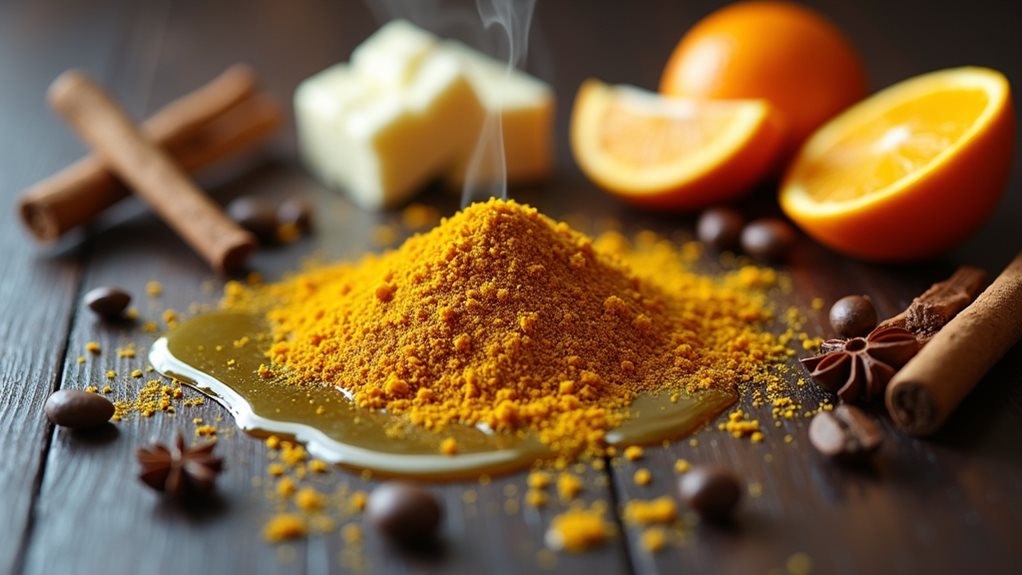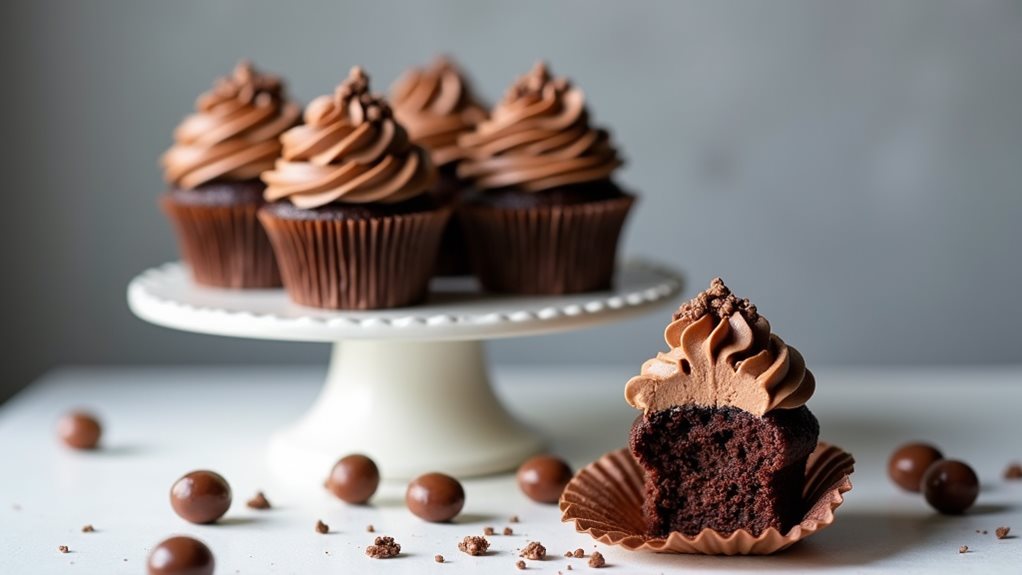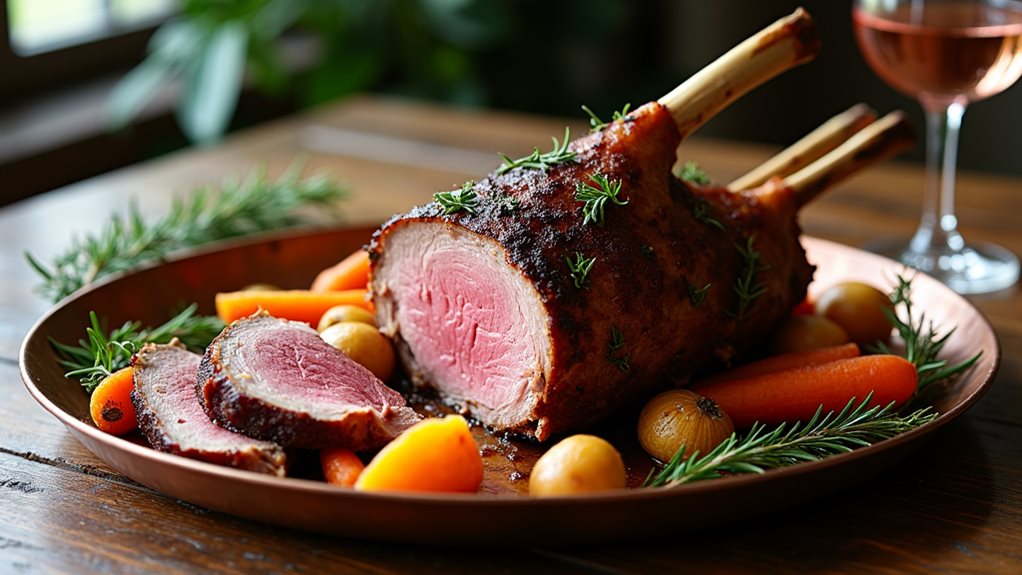Cardamom pairs beautifully with chocolate, coffee, citrus, and vanilla in sweet applications, while complementing cumin, coriander, and cinnamon in savory dishes. You'll find it enhances both dairy-based desserts and hearty meat preparations. For baking, combine it with nutmeg and cloves; for beverages, try it with ginger and honey. Toast whole pods before grinding to intensify flavor, and remember that green and black cardamom offer distinct profiles that aren't interchangeable. The world of cardamom combinations extends far beyond these fundamentals.
The Enchanting World of Green vs. Black Cardamom
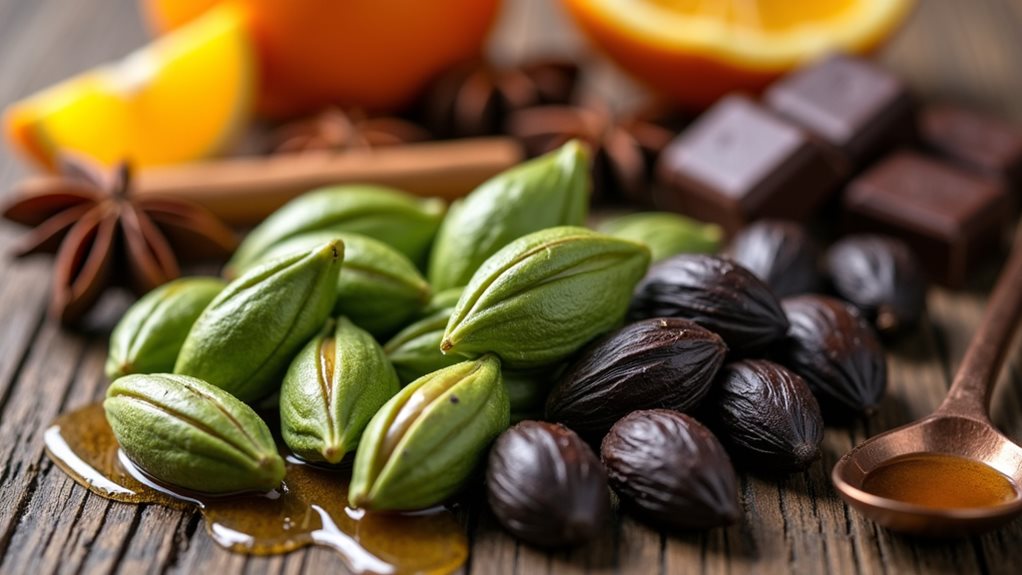
While many cooks are familiar with cardamom as a single spice, the distinction between green and black varieties reveals a fascinating depth of culinary possibilities.
You'll discover that green cardamom (*Elettaria cardamomum*) offers a sweet, floral profile that's perfect for both desserts and beverages, while black cardamom (*Amomum subulatum*) delivers an earthy, smoky character ideal for hearty dishes.
The green cardamom benefits extend beyond flavor—it improves circulation, promotes oral health, and aids digestion. Both varieties are extensively cultivated in Kerala and Sri Lanka, contributing significantly to these regions' spice economies.
Black cardamom origins trace to the Himalayan regions, where it's harvested at full maturity and dried over fire, giving it that distinctive smokiness.
When crafting innovative recipes, remember that these spices aren't interchangeable; green cardamom brightens sweet applications, while black cardamom deepens savory dishes with its bold intensity. White cardamom, which is essentially bleached green cardamom, provides a milder alternative for those seeking a more subtle flavor profile.
Cardamom in Scandinavian Baking Traditions
When you explore Scandinavian baking traditions, you'll find cardamom at the heart of classic sweet pairings like Swedish cardamom buns and coffee cakes, creating that distinctive Nordic flavor profile.
These baking customs trace back through ancient Nordic connections, with cardamom's earliest documented Scandinavian use appearing in a 13th-century Danish cookbook that featured Moorish influences.
The spice remains especially prominent in Yule breads and holiday treats, where its warming properties perfectly complement the region's cold winters and festive gatherings. In Sweden, cardamom cake is a beloved treat enjoyed during afternoon fika, the traditional coffee and cake break that punctuates daily life. The aromatic spice enhances the flavor of these baked goods when freshly ground seeds are used rather than pre-packaged ground cardamom.
Classic Sweet Pairings
Deeply rooted in Scandinavian baking traditions, cardamom has earned its place as the signature spice in countless sweet treats across Norway, Sweden, and Denmark.
You'll discover its distinct cardamom flavor profiles shining brightest when paired with simple, buttery bases that don't compete with its complex notes.
For ideal cardamom texture contrasts, combine it with moisture-rich ingredients like eggs, milk, and butter. The spice elevates humble cake batters into sophisticated treats, especially when paired with citrus zest or a dusting of powdered sugar. The multi-dimensional taste of cardamom creates depth in these baked goods that few other spices can achieve.
Swedish kardemummakaka exemplifies this perfect balance.
When baking with cardamom, you'll want to avoid overbaking at moderate temperatures (175-180°C) to preserve the delicate aromatics.
For the most authentic experience, try freshly ground cardamom seeds rather than pre-ground versions—the difference is remarkable.
The cake pairs wonderfully with fresh berries and fruit compotes, creating a harmonious blend of flavors ideal for a traditional fika coffee break.
Cardamom also imparts sophistication when infused in warm milk or cream for dessert infusions that can transform ordinary sweets into extraordinary treats.
Ancient Nordic Connections
The journey of cardamom into Scandinavian kitchens reveals one of history's most fascinating culinary migrations. Through ancient Viking trade routes that stretched across continents, this aromatic spice found its way from distant lands to become deeply embedded in Scandinavian heritage. Travelers can enjoy cardamom buns in cities as diverse as Tokyo and NYC, showing their global appeal.
You'll find cardamom's cultural significance reflected in everything from morning coffee rituals to celebratory holiday breads.
The spice routes that connected the Nordic region with the Middle East and India created a lasting culinary influence that has defined Scandinavian baking for centuries.
When you taste a traditional cardamom bun during a Swedish fika break, you're experiencing the living legacy of these historic connections. This cross-cultural exchange transformed an exotic foreign spice into something quintessentially Nordic—a demonstration of food's power to transcend borders.
While Vikings are often credited with introducing cardamom to Nordic lands, historical evidence suggests it may have actually arrived via Moorish trade connections through the Iberian Peninsula.
Yule Breads Tradition
At the heart of Scandinavian holiday celebrations stands julekake, a cardamom-infused sweet bread that transforms winter gatherings into aromatic feasts of tradition.
Julekake history traces back to the 17th century, when imported spices revolutionized Nordic baking, evolving from simple rye loaves to the enriched white flour creations we recognize today.
Cardamom significance in these breads can't be overstated—it's the distinctive flavor that defines Scandinavian Christmas baking.
You'll find this warm spice complementing the bread's candied citrus peels and raisins, creating a harmonious flavor profile that's been cherished for generations. The bread's dough must rise until doubled in size, typically requiring about 45 minutes before baking.
When served warm with butter, cheese, or jam, julekake doesn't just satisfy hunger—it connects you to centuries of Nordic heritage through its distinctive aromatic embrace. This versatile treat can also be enjoyed with smoked meats for a savory dimension to your holiday spread.
Mastering Cardamom in Indian Cuisine
Cardamom's versatility shines in Indian cuisine through three iconic preparations you'll want to master.
You can elevate your biryani by layering whole green cardamom pods between the rice and meat during the dum cooking process, allowing the aromatic oils to infuse gradually.
For authentic chai, you'll need to crack open cardamom pods before simmering them with black tea, creating that signature fragrance that's impossible to replicate with pre-ground spices.
When preparing kheer (rice pudding), you'll achieve the most delicate flavor by grinding fresh cardamom seeds with a mortar and pestle just before stirring them into the warm, creamy mixture.
This ancient spice has been cherished since the Neolithic period, much like lentils which were among the first domesticated crops.
Traditional Biryani Techniques
Traditional techniques for biryani preparation reveal how masterfully cardamom interacts with other ingredients in Indian cuisine, creating a symphony of flavors that has captivated diners for centuries.
When you're crafting authentic biryani, the layering process is essential—alternate partially cooked basmati rice with marinated meat to allow flavors to meld during dum cooking.
For best results, soak your rice for 30-40 minutes before cooking, then parboil it with whole spices including cardamom pods.
During marination, combine yogurt with a balanced spice blend where cardamom's sweet warmth complements cumin and coriander.
The final touch in biryani layering comes from saffron infusion—steep a few threads in warm milk before drizzling over the top layer.
This process creates distinctive flavor zones that harmonize during the sealed dum cooking process.
Aromatic Chai Mastery
When brewing the perfect cup of chai, mastering cardamom's aromatic profile transforms an ordinary beverage into an extraordinary sensory experience.
You'll discover that cardamom creates distinctive aromatic layers that complement warming spices like cinnamon and ginger. For ideal flavor extraction, add whole pods to your chai spice blend, allowing them to release their complex notes gradually.
Traditional techniques call for combining cardamom with black tea, creating depth that can't be achieved with other brew methods. For stronger infusions, try ground cardamom, but be mindful of spice balance—you want enhancement, not overpowering intensity.
Experiment with chai variations by pairing cardamom with rose petals or orange blossom water, especially in Middle Eastern-inspired recipes.
You'll find cardamom infusion works beautifully in tea-free alternatives too, giving you endless possibilities for aromatic innovation.
Consider incorporating cardamom into a fragrant herbal broth where its distinctive flavor can enhance both sweet and savory culinary creations.
Sweet Kheer Secrets
Delving into the world of Indian desserts reveals how cardamom transforms a simple rice pudding into the beloved delicacy known as kheer. This aromatic spice balances sweetness while adding complexity through its distinctive floral notes.
You'll find that mastering cardamom's role requires precision—too little disappears, too much overwhelms.
Try these innovative approaches to elevate your kheer:
- Experiment with kheer variations by substituting traditional rice with tapioca pearls or vermicelli.
- Combine cardamom with rose water and saffron for a multi-layered flavor profile.
- If you're out of cardamom, try cardamom substitutes like a blend of cinnamon and ginger.
Remember to add the spice during the slow cooking process, allowing it to infuse thoroughly as you constantly stir the thickening milk mixture. For a contemporary twist inspired by seasonal cooking, consider incorporating pumpkin puree into your kheer recipe for earthier autumn flavors.
Coffee and Tea Enhancements With Cardamom
Few spices transform ordinary beverages into aromatic experiences quite like cardamom does with coffee and tea. When exploring cardamom infusion techniques, try crushing pods before brewing to release their essential oils—this simple step dramatically enhances your drink's fragrance and depth.
For coffee flavor profiles, cardamom introduces citrusy, minty notes that complement coffee's natural bitterness. You'll find this combination particularly satisfying in a French press for smoothness or Turkish style for rich texture.
If your stomach typically reacts to acidic coffee, cardamom's digestive benefits may provide relief.
In tea, cardamom shines in traditional chai but works equally well as a standalone herbal infusion. Whether you're brewing a morning cup or hosting guests, cardamom-infused beverages offer both cultural richness and innovative flavor possibilities that elevate your daily ritual.
Chocolate and Cardamom: A Luxurious Pairing
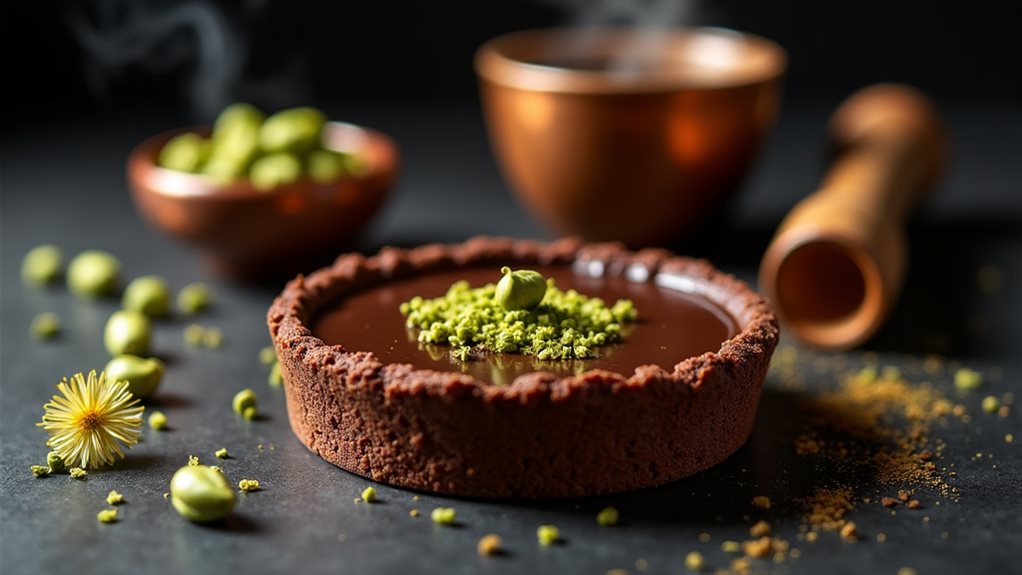
You'll discover pure magic when you pair the rich bitterness of dark chocolate with cardamom's warm, citrusy notes in your next dessert creation.
For an impressive treat, try making spiced chocolate bars by infusing melted dark chocolate with freshly ground cardamom, then adding nuts or dried fruits before setting.
These luxurious bars make excellent gifts during holidays or special occasions, combining the sophistication of fine chocolate with cardamom's exotic flair.
Dark Chocolate Magic
The marriage of cardamom and dark chocolate creates an extraordinary sensory experience that transforms ordinary desserts into luxurious indulgences.
This culinary fusion draws on cardamom history from Indian and Middle Eastern traditions, where the spice has been treasured for centuries.
When you combine green cardamom's bright, citrusy notes with dark chocolate's rich bitterness, you'll discover a balanced complexity that few flavor combinations can match.
Try these exceptional applications:
- Infuse warm milk with crushed cardamom pods before adding to your dark chocolate mousse.
- Sprinkle finely ground cardamom into dark chocolate cake batter for an aromatic twist.
- Add a pinch to whipped cream topping your chocolate desserts for an elevated finish.
You'll find this pairing particularly versatile in gluten-free and dairy-free adaptations, opening new creative possibilities for your culinary repertoire.
Spiced Dessert Bars
While dark chocolate offers an exquisite path for cardamom pairing, white chocolate brings an entirely different dimension to spiced dessert bars. The creamy sweetness creates a perfect canvas for cardamom's warm, spicy notes to shine without competition from cocoa's bitterness.
When crafting these luxurious treats, your spiced bar ingredients should create textural contrasts that complement the flavor complexity. Combine pistachios and dried apricots for crunch and chewiness against the smooth chocolate base.
The cardamom texture experience is enhanced when you gently melt white chocolate using a double boiler rather than microwave methods. After melting, fold in freshly ground cardamom and press rose petals onto the surface before cooling.
This technique guarantees even distribution of spice while creating a visually stunning dessert that honors cardamom's Indian and Middle Eastern heritage. For an additional layer of complexity, consider incorporating a hint of white miso paste to add an unexpected umami richness that beautifully balances the sweet and spicy elements.
Cardamom With Fruits: Unexpected Delights
Discovering unexpected fruit pairings with cardamom opens a world of flavor possibilities that can transform ordinary dishes into extraordinary culinary experiences.
The warm, aromatic notes of cardamom fruit create unexpected pairings that balance sweetness with complexity. You'll find tropical fruits like mango particularly receptive to cardamom's exotic character, while stone fruits such as peaches and apricots develop remarkable depth when enhanced with this spice.
- Try infusing lemonade or orange juice with cardamom for an instantly elevated beverage.
- Incorporate cardamom into fruit salads, especially those featuring apples or tropical fruits.
- Experiment with cardamom in fruit-based desserts like banana bread or mango kulfi.
These combinations showcase cardamom's versatility beyond traditional applications, inviting you to reimagine your culinary approach to both everyday and special occasion dishes.
Savory Applications for Cardamom in Global Cuisine
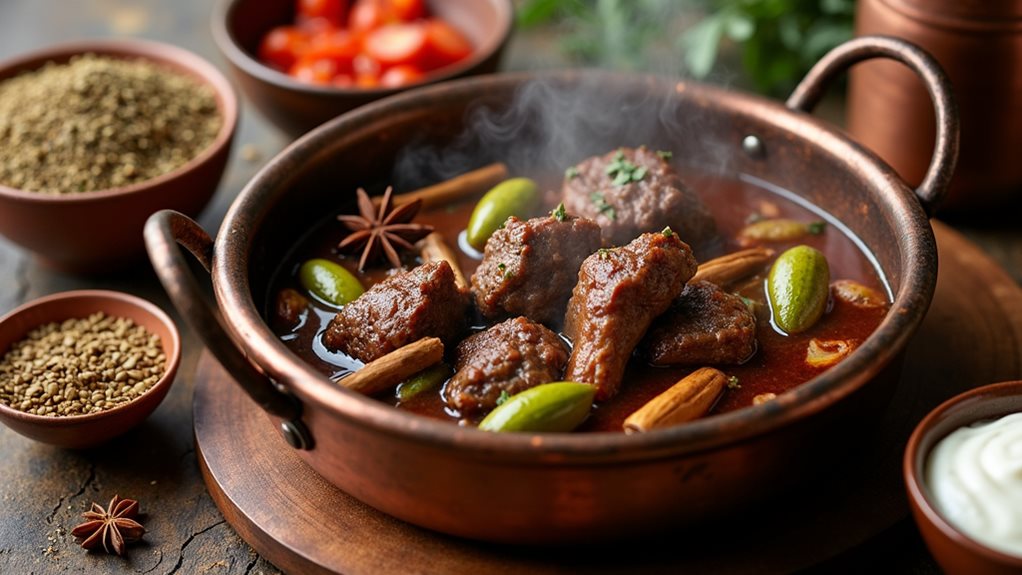
Moving beyond fruit pairings, cardamom's complex profile makes it a standout spice in savory dishes across global culinary traditions.
In Middle Eastern cuisine, you'll find it enhancing lamb dishes when combined with cumin and coriander, while Indian cardamom flavor profiles shine in garam masala, biryanis, and curries.
Cardamom, cumin, and coriander create the soul of Middle Eastern lamb, while India's iconic spice blends celebrate its aromatic complexity.
For culinary exploration, try incorporating cardamom into your next chickpea curry or lentil preparation. The warming notes work surprisingly well in Nordic braises, where it transforms slow-cooked meats.
When making soups or stews, add cardamom with cinnamon and ginger for depth that elevates ordinary recipes to extraordinary experiences.
Don't forget less common applications—cardamom can revolutionize your homemade dips or vegetable dishes, particularly when paired with black pepper for a balanced zesty undertone.
Creating Your Own Cardamom Spice Blends
Three fundamental principles govern successful cardamom spice blends: balance, freshness, and inspiration.
When you're experimenting with spice blending, remember that cardamom works harmoniously with both sweet and savory companions. Toast your spices briefly before grinding to release their essential oils and enhance their aromas—particularly important for cardamom seeds, coriander, and cumin.
- Balance sweet and warm notes by combining cardamom with cinnamon and nutmeg for baked goods, or with cumin and coriander for savory dishes.
- Experiment with cooling effects by pairing cardamom with ginger, mint, or turmeric.
- Draw regional inspiration from Lebanese Baharat or Indian Garam Masala for authentic flavor balancing.
Store your freshly ground blends in airtight containers to preserve their complex flavor profiles and aromatic qualities.
Consider using a pressure cooker to prepare dishes with your cardamom blends, as pressure cooking retains more flavor compounds than traditional boiling methods.
Cardamom in Modern Cocktails and Beverages
Cardamom's versatility extends beyond traditional spice blends and into the world of modern mixology, where it's revolutionizing cocktail culture with its complex, aromatic profile.
You'll find innovative cardamom flavor profiles in everything from an updated Old Fashioned to elegant champagne cocktails, where its sweet, spicy, and floral notes create multi-dimensional taste experiences.
Master cardamom infusion techniques by creating simple syrups with lightly toasted pods, or try cold infusion for smoother extraction.
Lightly toast your cardamom pods before infusion—this simple step unlocks their full aromatic potential in every drop.
Pair cardamom with warming spices like cinnamon and ginger for fall cocktails, or combine it with citrus for invigorating summer drinks.
Whether you're crafting a sophisticated cardamom-infused coffee or experimenting with cardamom bitters in classic recipes, this versatile spice adds depth that transforms ordinary beverages into extraordinary sensory experiences.
When and How to Substitute Cardamom
When you're halfway through a recipe and realize you've run out of cardamom, you don't need to panic or abandon your culinary plans. Several common spices can effectively take cardamom's place, depending on your dish.
When substituting spices, consider these practical approaches:
- For curry dishes – Use equal parts cinnamon and ginger to mimic cardamom's warm complexity, starting with less and adjusting flavors as you go.
- For baking projects – Try a blend of nutmeg, cinnamon, ginger, and cloves in equal proportions for a well-rounded flavor profile.
- For beverages – Apple pie spice or a pinch of cinnamon with a hint of ginger works surprisingly well.
Remember that cardamom's unique floral and citrus notes can't be perfectly replicated, but thoughtful combinations can still produce excellent results. For the most innovative results, try experimenting with herb ratios to discover your preferred flavor profile when making these substitutions.
Frequently Asked Questions
Can Cardamom Be Used in Meat Marinades?
Yes, you'll love using cardamom in meat marinades! It's excellent with beef, lamb, and chicken. Try combining it with cumin, citrus, and olive oil for innovative cardamom meat marinade recipes that'll transform your grilling.
How Long Does Ground Cardamom Retain Its Flavor?
Ground cardamom's flavor longevity is 3-4 months when stored properly. You'll maximize its aromatic potential by keeping it in airtight, dark containers. For innovative cooking, proper ground cardamom storage is essential to maintaining its distinctive punch.
Is Cardamom Safe During Pregnancy?
Cardamom is generally safe during pregnancy when used in moderation. You'll benefit from its digestive relief and nutrients, but always consider herbal considerations and consult your healthcare provider about pregnancy safety before making significant changes.
Can Cardamom Pods Be Reused After Brewing?
Did you know 85% of cardamom's flavor remains after first use? You can absolutely reuse cardamom pods after brewing. Just dry them thoroughly and incorporate them into your next innovative brewing techniques for a subtle cardamom reuse experience.
Does Cardamom Have Medicinal or Digestive Benefits?
Yes, you'll find cardamom offers impressive benefits for digestive health through its gas-relieving oils and antimicrobial properties. It's also packed with anti-inflammatory compounds and antioxidants that may help fight chronic diseases and cancer cells.
Final Thoughts
You're now equipped to explore cardamom's versatile flavor profile in countless culinary applications. Whether pairing it with chocolate in decadent desserts or incorporating it into savory dishes, your understanding of both green and black varieties gives you a significant advantage. Curiously, cardamom remains the world's third-most expensive spice by weight, behind only saffron and vanilla, reflecting its enduring value in global cuisine. Experiment with these pairings to discover your own signature combinations.

